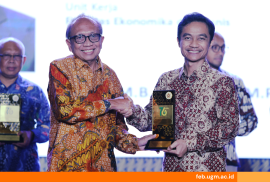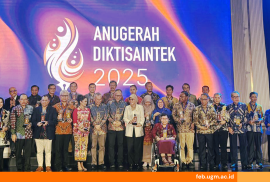The price of rice in Indonesia has increased significantly in recent times. The increase in rice prices reached IDR 18,000 per kg at the end of February 2024, becoming the country’s highest record in the history of rice. This increase exceeds the highest retail price (HET) the government sets.
In response to this phenomenon, the UGM Center for Poverty and Inequality Alleviation Studies (EQUITAS), Faculty of Economics and Business (FEB) presented the results of a study related to national rice. EQUITAS FEB UGM Coordinator Wisnu Setiadi Nugroho, PhD, said increasing rice prices would hinder economic progress. The many intermediaries between farmers and consumers have significantly contributed to Indonesia’s substantial increase in rice prices.
“This caused the highest rice price in history,” said Wisnu, Wednesday (24/4) at the FEB UGM campus.
Katadata 2023 data records that in 2022/2023, Indonesia will consume 35.3 million metric tons of rice. Meanwhile, CNBC 2023 data shows that 98.35% of Indonesians encourage this sustainable increase, including rice in their diet. However, the recent surge in rice prices has had a significant impact on a large number of individuals, especially those from poor households. As reported by the Indonesian Central Statistics Agency (BPS) in February 2024, the price of premium rice in Indonesia fluctuated to IDR 14,525 per kilogram. This represents an increase of 8.82% compared to December 2023 and a substantial jump of around 22.91% compared to prices in February 2023.
“Rice prices have increased by 19.38 per cent in urban areas and 23.04 per cent in rural areas. “This gap emphasizes the impact of a complex supply chain on the affordability of rice prices in Indonesia compared to other developing countries,” explained this lecturer at the Department of Economics, FEB UGM.
Tracing the Effect of Rising Rice Prices
Vishnu explained that various factors influenced the increase in rice prices. Some of them include scarcity of supply and increasing demand. In Indonesia’s case, volatility is also a factor that contributes to price increases. Instability in availability often stems from logistical challenges and insufficient production. Logistically, Indonesia, as a developing country, is grappling with continuous challenges. Research conducted by Reardon and Timmer (2012) revealed that in developing countries, supply chains are characterized by geographic length and relatively short intermediaries.
Vishnu reiterated that the many intermediaries between farmers and consumers contributed significantly to Indonesia’s relatively significant increase in rice prices. This phenomenon causes the price of rice in Indonesia to be higher than that of other developing countries. For example, in India, rice prices range between IDR 10,140 – and IDR 32,136 per kilogram. Next, in China, the price range for rice is between IDR 12,012 – and IDR 23,868 per kilogram.
Wisnu said that this gap shows the impact of a complex supply chain on the affordability of rice prices in Indonesia compared to various other developing countries. Indonesia’s logistics complexities include inadequate transportation infrastructure, lack of storage facilities, and difficulties coordinating between various supply chain actors. These challenges result in delays, inefficiencies and increased costs, ultimately increasing rice prices. The lack of profits available to rice farmers is another significant factor contributing to the spike in rice prices.
Wisnu further explained that this condition can be seen from research conducted by Ceballos, Hernandez, Minot, and Robles, which emphasized that the world rice market is characterized by unstable and unreliable supply (Krisnamurthi & Utami, 2022). The research highlights two main factors contributing to low rice production in Indonesia: the slow mechanization process and limited investment in research and development. Meanwhile, Dawe, Timmer, and Warr (2014) emphasized the inaccuracy of rice production data issued by the Ministry of Agriculture and linked it to estimation problems. Both BPS and the Ministry of Agriculture use tile surveys and eye estimation approaches to assess the area of cultivated land, which results in overestimations. Several studies show a 17 per cent overestimation for rice production and harvested land area in 1996-1997. Other findings show an overestimation of 13 per cent for the total rice production in 2000-2001, as identified by the Japan International Cooperation Agency (JICA).
Vishnu said that changes in seasonal patterns are also one of the factors that exacerbate fluctuations in production levels. A study conducted by Ansari et al. (2023) shows Indonesia’s vulnerability to climate change, which can be seen from the prolonged drought that will occur in 2024, causing delays in the harvest period. These disruptions and increased demand for rice driven by the political cycle are increasing pressure on already tight supply chains. Legislative candidates purchased large quantities of rice to distribute to voters to increase their electoral appeal. This condition increasingly burdens the supply chain and exacerbates demand pressures.
Strategy to Reduce the Impact of Rising Rice Prices
Meanwhile, Jamilatuzzahro, M.Si., also a researcher at EQUITAS FEB UGM, said that the Indonesian government has adopted a diverse approach to maintaining the affordability and accessibility of rice. Four main strategies were created to overcome rising rice prices: market operations, the rice program for low-income families (Raskin), domestic procurement, and imports. The Raskin program differentiates itself from other initiatives by not directly influencing market dynamics. Instead, this program is exclusively dedicated to increasing rice accessibility for low-income families by providing subsidized rice to low-income households, ensuring food security. On the other hand, through market operations, the government seeks to stabilize rice prices by releasing specific quantities of rice to the market at a predetermined price. This strategic intervention aims to achieve price stability and ensure that rice remains within the financial reach of the community.
Next, domestic procurement to overcome rice supply problems is used only under certain conditions. This is done primarily when the existing challenges lie only on demand. In order to work, domestic procurement requires at least one or several provinces with a rice surplus that can be allocated to provinces that experience a deficit.
“This approach is generally better suited to dealing with demand fluctuations rather than production shortages,” he explained.
Furthermore, importing rice from neighbouring countries such as Thailand and Vietnam is the final option to overcome rising rice prices. This import aims to moderate domestic market prices by taking advantage of the cost of imported rice, historically lower than local rice, to stabilize prices. However, this import could be politically sensitive because it has the potential to impact agriculture and domestic farmers who are threatened with competition from cheaper imported rice. Therefore, regulations surrounding rice imports are often designed to protect domestic agriculture and maintain food security by minimizing dependence on external sources.
Efforts to Overcome Price Volatility
Jamilatuzzahro said failure to recognize the complexity can lead to ineffective policies that increase volatility instead of reducing it. According to him, it is necessary to carry out planned imports and controlled market operations in the short term. These two steps are essential strategies that can be implemented. Additionally, improving market information systems to reduce price volatility will help governments manage and respond to risks related to prices, weather, or other hazards.
“Planned or scheduled imports and market operations can also minimize speculative actions from irresponsible market players,” he said.
Meanwhile, in the long term, small farmers will be empowered through access to technology. Data from McKinsey (2020) estimates that using modern technology in the agricultural sector can increase economic output by up to US$6.6 billion per year. Modern harvesting technology is considered profitable and can do many people’s work in a short time more precisely and accurately than traditional harvesting.
The next step is to improve logistics channels by cutting out intermediaries, which can significantly increase the efficiency and equal distribution of rice in Indonesia. Technology platforms or farmer cooperatives can facilitate direct relationships between farmers and millers. By establishing direct channels, farmers can negotiate fair prices for their crops while ensuring millers get rice competitively, reducing dependence on intermediaries.
No less critical, Jamilatuzzahro added that infrastructure development plays a vital role in overcoming fluctuations in rice prices in the country. This is because building roads, transportation networks and storage facilities can reduce transportation costs and increase the efficiency of rice distribution. The need for intermediaries who often charge high fees for transportation and storage services can be reduced by improving infrastructure.
“This can facilitate the distribution of rice from agricultural land to markets more quickly and cost-effectively,” he concluded.
Writer: Wisnu Setiadi Nugroho and Jamilatuzzahro
Photo: freepik.com










